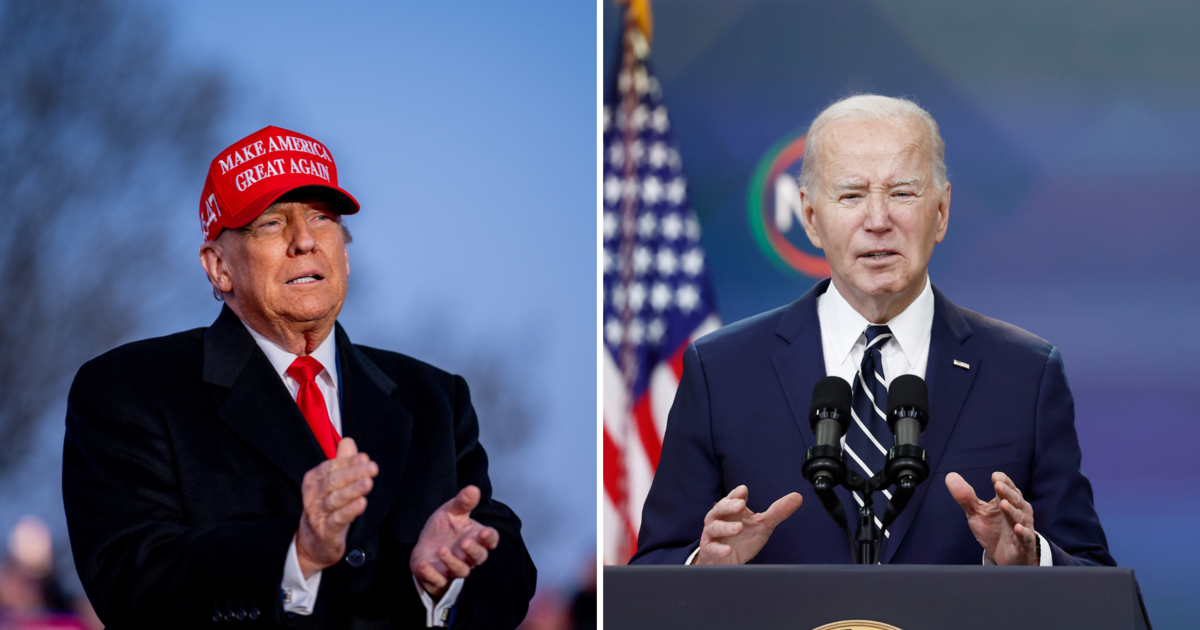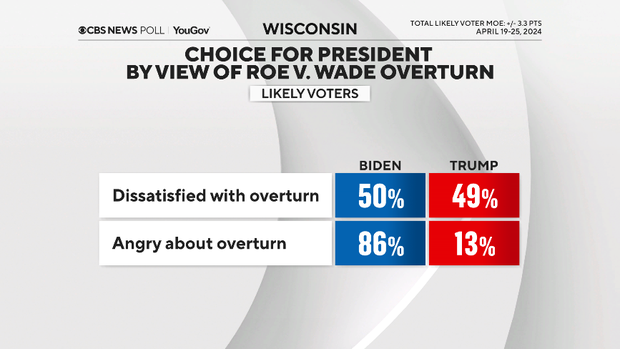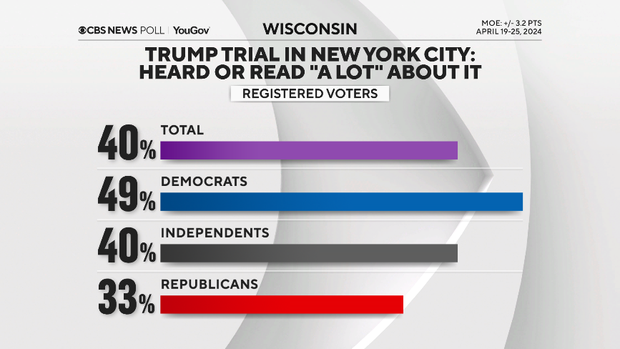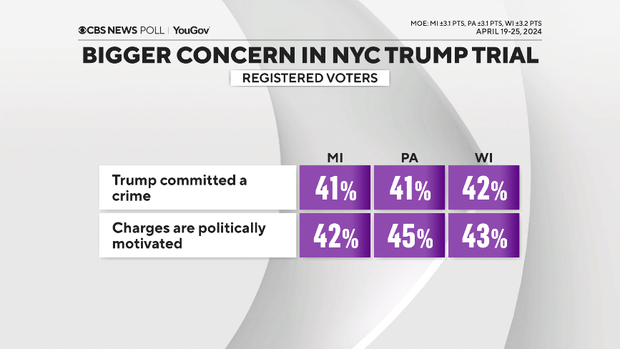CBS News
CBS News poll finds Biden-Trump race tight in Michigan, Pennsylvania, Wisconsin

For years, they’ve been three of the handful of states that decided presidential elections. In the summer of 2020, amid the COVID pandemic and lockdown debates, sizable majorities in Michigan, Wisconsin, and Pennsylvania rated state economies badly. Incumbent President Donald Trump trailed in polls, and ultimately, the three close contests were won by challenger Joe Biden.
Four years on, some things haven’t changed. We have the same two candidates locked in close — effectively even — races. And there are still negative views of the economy that now, as then, weigh on the 2024 incumbent, President Biden.
Given the views of these candidates, the summer campaign here might be an argument about who is the less bad option: both candidates elicit more feelings of worry than confidence, more insecurity than security, and plenty of anger.
With inflation looming large in their minds, most voters don’t say there’s even been improvement in their state’s economy post-pandemic: only a quarter say it has improved in the years since, with about half saying it has actually gotten worse.
And few say their own finances are better compared to before the pandemic. This may be an essential part of their memory — comparing to before the coronavirus.
Amid those poor economic numbers, here’s a change that’s working against Mr. Biden: he narrowly trails Donald Trump on “understands the needs and concerns of people like you.” That means he’s losing an edge he enjoyed in the summer of 2020 when we asked voters in Pennsylvania and Wisconsin this question.
The choice between Mr. Biden and Trump now predominantly draws out negative feelings like worry and anger.
Twice as many say Mr. Biden makes them feel worried as say he makes them feel either secure or confident. He trails Trump on making voters feel confident and secure.
Trump, for his part, elicits more feelings of anger, which does fuel opposition to him, helping keep Mr. Biden in these races, despite sour economic views.
Another change is that voters are less likely to see Mr. Biden as “moderate” now than they were in 2020, blunting another item that worked to his advantage four years ago. The percentage of self-described moderates who see Biden as a moderate has decreased.
Finances and the economy
As we’ve seen nationwide, voters today recall their state’s economy “when Donald Trump was president” quite differently from the way it was viewed back in 2020, specifically. Ratings of the economy were quite low that year. So it may well be that when they think back about the Trump years, they’re thinking back to before the pandemic. That matters a lot for how they perceive their choice of Trump and Mr. Biden now.
Thinking in retrospect about the economy under Trump while skipping over the pandemic in 2020 lends itself to a more favorable comparison with the economy now, under Mr. Biden. Moreover, many voters say their own finances today are worse than during the time before the pandemic.
And so, today we find plenty of voters want to change back: in all three states, many believe they would be financially better off with Trump back in office. Voters who feel this way are voting for him in large numbers.
Mr. Biden’s perceived advantage on helping the middle class instead of the wealthy, at least relative to Trump, has taken a hit in Pennsylvania since the fall of 2020. That fall, voters felt Mr. Biden’s policies would be less likely than Trump’s to favor the wealthy. That’s still the case, but today, the gap between the two candidates has narrowed.
Defining the stakes
So, given all that economic pessimism, what keeps Biden even?
First, there are other issues.
There’s an ongoing battle between the campaigns to define the stakes of the election this year. The Biden camp is pressing perceived risks to democracy, including infringements on rights, while the Trump campaign is hammering the incumbent on the economy.
Many rank both economy and democracy as important because it’s not an either-or-choice, but more rate the economy and inflation as major factors, compared to the state of democracy.
That advantages Trump, partly because he does a little better among those prioritizing the economy than Mr. Biden does with voters ranking democracy highly.
Abortion
It may be a state issue on policy, but it’s national politically — especially for Democrats — and it does accrue to their advantage.
Sizable numbers in these states express anger about Roe v. Wade being overturned — most of them blame Trump for it, and they’re overwhelmingly backing Mr. Biden.
Most voters in Pennsylvania, Wisconsin and Michigan report paying attention to events in other states like Florida and Arizona, so what individual states do has some national resonance.
That said, the race is more competitive among voters who are dissatisfied but not angry about the Dobbs decision that overturned Roe v. Wade.
These are voters to watch in the coming months. They could become potential persuasion targets for the Biden campaign, because most of them do favor abortion being legal in their state but don’t blame Trump for the overturning of Roe. The question will be whether they increase in anger, in blame of Trump, or in the salience of the issue overall.
Overall, abortion is still not as salient across the whole electorate as economic concerns. It trails far behind the economy and inflation, among other factors in each state.
And how people feel about the financial impact of the next president is more closely related to their vote than whether they want abortion to be legal or not.
Trump’s trial: not much of a factor
Trump’s trial in New York isn’t much of a factor at the moment because it’s mostly Democrats and Biden voters who are paying attention, in the form of hearing or reading a lot about it.
And even among Trump voters, the ones already strong in their support of him — and therefore, unlikely to be moved by much — are the ones who report paying more attention than do his less-committed supporters.
Overall, voters are equally likely to be concerned that the charges are politically motivated as they are that Trump committed a crime.
Breaking down vote patterns
Here’s another notable change from 2020, and it’s within each candidate’s support set, perhaps reflecting voter displeasure with having this rematch:
Each candidate’s “very strong” support number among backers is lower than it was in 2020 even though, at the same time, very few of them say they would ever consider switching candidates.
So, with this kind of dynamic, it would not be surprising to see lower turnout rates or even higher third-party voting than the last election saw.
Biden and young voters
There’s been a lot of discussion about Mr. Biden’s slipping approval among younger voters and about his handling of the Israel-Hamas conflict. However, approving is not the same as voting. One is an evaluation, the other, a choice.
The young voters who want Mr. Biden to tell Israel to stop its military actions in Gaza are still voting for him, at about the same rate as younger voters overall. That said, expressed vote choice now isn’t the same as turning out in November, and as a group, young voters aren’t as likely to say they will.
A Biden administration proposal that is popular with younger voters is canceling some student loan debt. Solid majorities of voters under 45 approve, and those who do are backing Mr. Biden in large numbers. And if they aren’t backing him, those who approve of the plan are more likely to say they would consider voting for him.
Third-party tests
In political polling, third-party measures can mean a lot of things. Sometimes they’re genuine support, sometimes they’re a way to voice a protest early in a cycle. Third-party candidates have tended to poll better than they perform at the ballot box in recent years, as some voters dissatisfied with major-party nominees simply don’t show up to vote at all. Either way, it’ll certainly be a story to watch in 2024 in states where such candidates are on the ballot.
In Michigan, with the presence of Robert F. Kennedy, Jr. the net gap between Mr. Biden and Trump is the same, but Kennedy looks like he’s drawing more interest from the kinds of voters backing Trump than backing Mr. Biden.
Most of those picking Kennedy in a four-way ballot test backed Trump initially in a two-way race with Mr. Biden, including leaners.
Kennedy’s supporters look more like Republicans than Democrats on a variety of measures, including their views on the economy, immigrants, and Trump’s trial, as well as how they voted recently, despite the fact that they often identify as moderates. (That can mean they just don’t feel at home in the usual political labels.)
And eight in 10 say Mr. Biden makes them feel worried, while only half say so of Trump.
It’s important to consider who picks each candidate, not just where the horse race ends up, when looking at the impact going forward in a campaign.
These CBS News/YouGov surveys were conducted between April 19-25, 2024. They are based on representative samples of 1,287 registered voters in Michigan, 1,306 in Pennsylvania, and 1,245 in Wisconsin. Margins of error for registered voters: Michigan +/- 3.1 points, Pennsylvania +/- 3.1 points, and Wisconsin +/- 3.2 points.
CBS News
FAA bans drones over several New Jersey towns. See the list.

NEW YORK — Drones have been banned from flying over several New Jersey towns, the Federal Aviation Administration confirms to CBS News.
The FAA order covers nearly two dozen towns, including Jersey City, Harrison, Edison, Bayonne and Camden. It will be in effect until Jan. 17.
The order says no unmanned aircraft can operate below 400 feet within one nautical mile of the airspace specified in each area. Additionally, it allows the government to use “deadly force” against the drones if they pose an “imminent security threat.”
“Pilots of aircraft that do not adhere to the procedures in the national security requirements for aircraft operations contained in this section may be intercepted, and/or detained and interviewed by federal, state, or local law enforcement or other government personnel,” the order reads in part.
Several of the zones are centered around infrastructure, like power substations. Others cover areas like the Kearny, New Jersey port and airspace around military installations like Joint Base McGuire-Dix-Lakehurst in South Jersey, or airports such as Newark-Liberty International Airport.
Earlier this month, the Florham Park, New Jersey police chief told residents drone sightings had been reported above “water reservoirs, electric transmission lines, rail stations, police departments, and military installations.”
Where are drones banned in New Jersey?
North Jersey:
- Cedar Grove
- Bridgewater
- North Brunswick
- Metuchen
- South Brunswick
- Edison
- Branchburg
- Sewaren
- Jersey City
- Harrison, Essex County
- Elizabeth
- Bayonne
- Clifton
- Kearny
Central Jersey:
South Jersey:
- Burlington
- Evesham
- Camden
- Gloucester City
- Westampton
- Winslow
- Hancocks Bridge, Salem County
See the full order from the FAA here.
Mysterious drones over New Jersey and beyond
Drones sightings have been reported all month long, first over Morris County, New Jersey and then over several other East Coast states.
Federal, state and local officials have been demanding more information about where they are coming from and what’s being done to stop them. The FBI is leading the investigation and tells CBS News it has received thousands of tips.
While the White House says there is no known threat, New Jersey Gov. Phil Murphy recently sent a letter to President Joe Biden asking for more federal resources.
On Wednesday, a push from Sen. Chuck Schumer to give local law enforcement more ways to track drones was blocked in the Senate.
Check back soon for the latest updates on this developing story.
contributed to this report.
CBS News
2 bus crashes in Afghanistan leave dozens dead, dozens more hurt

Two highway crashes in southeastern Afghanistan killed a combined total of 50 people and injured 76, a government spokesman said Thursday.
One was a collision between a bus and an oil tanker on the Kabul-Kandahar highway late Wednesday, said Hafiz Omar, a spokesman for the governor of Ghazni province.
The other, also late Wednesday and in the same province, was in a different area of the same highway, which connects the Afghan capital with the south.
MOHAMMAD FAISAL NAWEED / AFP via Getty Images
Hamidullah Nisar, the provincial head of the Taliban-run Information and Culture Department, told the Reuters news agency the other accident involved a cargo truck, adding that some of those injured in both collisions were in critical condition.
Omar said many of the injured were taken to hospitals in Ghazni and patients in more serious condition were transferred to Kabul. Women and children were among the casualties, he said.
Authorities were in the process of handing over the bodies to families, Omar said.
MOHAMMAD FAISAL NAWEED / AFP via Getty Images
Crash survivor Abdullah Khan, who was being treated in a Ghazni hospital, said he didn’t know how many people had either died or were injured.
“I got out from the bus myself and heard the sound of moaning. There was blood everywhere. Some people had head injuries and others had hurt their legs.”
MOHAMMAD FAISAL NAWEED / AFP via Getty Images
Traffic accidents are common in Afghanistan, mainly due to poor road conditions and driver carelessness.
MOHAMMAD FAISAL NAWEED / AFP via Getty Images
CBS News
France’s President Emmanuel Macron tours cyclone-battered Mayotte, meets survivors pleading for help

Mamoudzou, Mayotte — France’s President Emmanuel Macron traveled Thursday to the Indian Ocean archipelago of Mayotte to survey the devastation that Cyclone Chido wrought across the French territory as thousands of people tried to cope without bare essentials such as water or electricity.
“Mayotte is demolished,” an airport security agent told Macron as soon as he stepped off the plane.
The security agent, Assane Haloi, said her family members, including small children, are without water or electricity and have nowhere to go after the strongest cyclone in nearly a century ripped through the French territory of Mayotte off the coast of Africa on Saturday.
KWEZI/AFP/Getty
“There’s no roof, there’s nothing. No water, no food, no electricity. We can’t even shelter, we are all wet with our children covering ourselves with whatever we have so that we can sleep,” she said, asking for emergency aid.
Macron got a helicopter tour of the damage and was to spend Thursday night on the far-flung French territory. After flying over the destruction, he headed to the hospital in Mamoudzou, Mayotte’s capital, to meet medical staff and patients.
Wearing a traditional Mayotte scarf on his white shirt and tie, sleeves rolled to the elbows, the French president listened to people asking for help. A member of the medical staff told him some people hadn’t had a drink of water for 48 hours.
Some residents also expressed agony at not knowing about those who have died or are still missing, partly because of the Muslim practice of burying the dead within 24 hours.
LUDOVIC MARIN/POOL/AFP/Getty
“We’re dealing with open-air mass graves,” Mayotte lawmaker Estelle Youssoufa told reporters. “There are no rescuers, no one has come to recover the buried bodies.”
Some survivors and aid groups have described hasty burials and the stench of bodies.
Macron acknowledged that many who died hadn’t been reported. He said phone services will be repaired “in the coming days” so that people can report their missing loved ones.
French authorities have said at least 31 people died and more than 1,500 people were injured, more than 200 critically. But it’s feared hundreds or even thousands of people have died in total.
Abdou Houmadou, 27, said emergency aid was needed immediately, not Macron’s presence.
“Mr. President, what I’d like to tell you… is I think the spending you made from Paris to Mayotte would have been better spent to help the people,” he said.
Another resident, Ahamadi Mohammed, said Macron’s visit “is a good thing because he’ll be able to see by himself the damage.”
“I think that we’ll then get significant aid to try and get the island back on its feet,” the 58-year-old said.
LUDOVIC MARIN/POOL/AFP/Getty
Macron’s office said four tons of food and medical aid, as well as additional rescuers, were aboard the president’s flight. A navy ship was due to arrive in Mayotte on Thursday with another 180 tons of aid and equipment, according to the French military.
People living in a large slum on the outskirts of Mamoudzou were some of the hardest hit by the cyclone. Many lost their houses, some lost friends.
Nassirou Hamidouni sheltered in his house when the cyclone hit.
His neighbor was killed when his house collapsed on him and his six children. Hamidouni and others dug through the rubble to reach them.
The 28-year-old father of five is now trying to rebuild his own house, which was also destroyed.
He believes the death toll is much higher than what’s officially being reported, given the severity of what he lived through.
“It was very hard,” he said.
Mayotte, located in the Indian Ocean between mainland Africa’s east coast and northern Madagascar, is France’s poorest territory.
The cyclone devastated entire neighborhoods and many people ignored the warnings, thinking the storm wouldn’t be so extreme.
Mayotte has more than 320,000 residents according to the French government. Most are Muslim and French authorities have estimated another 100,000 migrants live there.
Mayotte is the only part of the Comoros archipelago that voted to remain a part of France in a 1974 referendum.
Over the last decade, the French territory has seen a massive influx of migrants from the neighboring islands – the independent nation of Comoros, which is one of the world’s poorest countries.



































